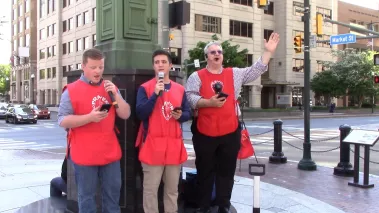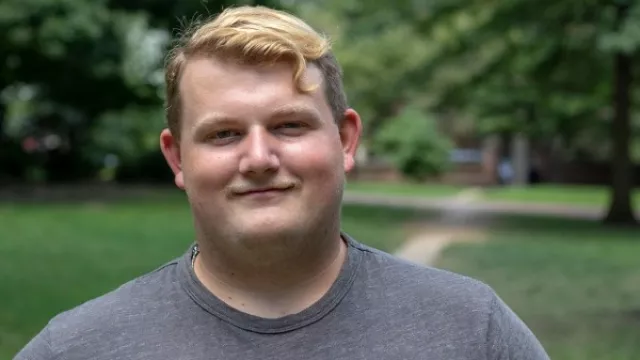Table of Contents
FIRE asks Supreme Court to uphold free speech on public sidewalks

Evangelism Mission / Facebook.com
Evangelist Rodney Keister (right) preaches on a street corner in Harrisburg on May 19, 2022.
Last week, FIRE filed an amicus curiae — “friend of the court” — brief, asking the Supreme Court of the United States to hear a case concerning whether a public university can restrict access to a public sidewalk on its campus. If the Court takes the case, the result will have big implications for campus speech everywhere, not just on public city sidewalks.
Public sidewalks occupy a unique place in the American free speech tradition. Historically, under the First Amendment, public sidewalks, streets, and parks have always been open to free expression. As a result, the Supreme Court has repeatedly held that governments usually cannot limit free speech on public sidewalks.
Unfortunately, administrators at state-sponsored colleges and universities too often decide to ignore this history and the clear commands of the First Amendment. That’s exactly what happened in this case, Keister v. Bell.
In Tuscaloosa, Alabama, administrators at the University of Alabama — a state-run school bound by the First Amendment — told Rodney Keister, a traveling Christian evangelist, that he couldn’t speak to students or hand out religious pamphlets on a public city sidewalk. Even though the sidewalk was owned by the city, ran along a public road, and passed in front of several private, non-university buildings, the school argued that the sidewalk was part of the school’s campus because a single university building is located on that block. In the university’s view, this enables it to limit the public’s right to engage in free speech on that sidewalk.
Amazingly, despite several other federal courts of appeals holding that universities cannot restrict speech under similar circumstances, the U.S. Court of Appeals for the Eleventh Circuit sided with the university. The court held that not only can public universities limit free speech on campus sidewalks, but they can also limit free speech on public city sidewalks so long as they pass in front of a single campus building.
The Eleventh Circuit’s holding is doubly wrong.
Today, many administrators treat their campuses as fiefdoms, their students as peons, and non-students like Mr. Keister as invading ants.
Not only can government actors, including public institutions like the University of Alabama, not restrict speech on city sidewalks, but they also cannot restrict free speech on campus sidewalks — or campus green areas and public spaces, for that matter. As the Supreme Court held in the 1972 case of Healy v. James, “state colleges and universities are not enclaves immune from the sweep of the First Amendment.” FIRE has worked for decades to remind students, administrators, courts, legislators, and the general public of this long-established law.
For example, FIRE’s Legislative Policy team has for years encouraged states to pass campus free speech statutes that clarify that sidewalks, lawns, and other public spaces on state-run campuses are First Amendment-protected areas. Similarly, FIRE’s campus Policy Reform team works with both public and private colleges and universities, encouraging them to adopt speech-friendly policies, and publishes an annual report spotlighting good and bad speech policies at campuses across the country.
But oftentimes, as was the case with Mr. Keister and the University of Alabama, these legislative and policy efforts are not enough. As FIRE remarked in its amicus brief, “Today, many administrators treat their campuses as fiefdoms, their students as peons, and non-students like Mr. Keister as invading ants.” When that happens, FIRE’s Campus Rights Advocacy and Litigation teams often have to send letters or even take legal action against public universities to force them to comply with the First Amendment.
It’s clear that when left alone, public colleges and universities often choose to ignore the First Amendment.
Sometimes a letter is enough. For example, in 2019, FIRE wrote to Western Illinois University, calling on the school to finally abolish its “free speech zone” policy that it had promised to get rid of 16 years earlier. Literal speech police resurrected the supposedly eliminated policy to shut down a student event advocating for marijuana legalization. After FIRE’s letter, the university finally removed the policy in 2020.
Too often, legal action is required. That was true in the case of FIRE client Kevin Shaw, a student at Los Angeles Pierce College. Administrators at his public community college threatened to remove him from campus for distributing Spanish-language copies of the Constitution outside the school’s designated “Free Speech Area,” a tiny area that occupied only 0.007% of campus, or the ratio of an iPhone to a tennis court. The school settled and fixed its unconstitutional policies only after losing in court.

UPDATE: Court rejects Jones County Junior College’s attempt to dismiss lawsuit by former student Mike Brown
In another FIRE court victory, campus police repeatedly threatened Jones County Junior College student Mike Brown for rolling a “free speech ball” (a beach ball with words written in sharpie) around campus without advance permission, and for advocating for marijuana legalization in the campus plaza. The school finally agreed to modify its policies, and adopt the “Chicago Statement” after a judge refused to dismiss Brown’s lawsuit.
It’s clear that when left alone, public colleges and universities often choose to ignore the First Amendment. As FIRE’s amicus brief notes, that is especially true “when speech is inconvenient, unpopular, or critical of the school” — exactly the type of speech the First Amendment was designed to protect. The Supreme Court should step in and make clear once and for all to public university bureaucrats that the First Amendment applies to them, too, especially on public sidewalks.
You can read more about the case and FIRE’s full brief here.
Recent Articles
Get the latest free speech news and analysis from FIRE.

Can the government ban controversial public holiday displays?

The trouble with banning Fizz

FIRE's 2025 impact in court, on campus, and in our culture


